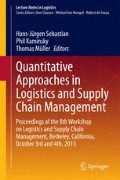Abstract
Maintenance Supply Chain (MSC) involves Maintenance, Repair and Overhaul (MRO) organizations and the relationships within and across suppliers and customers. These organizations work with the probability of equipment failure, maintenance and user requirements of spare parts. All of these elements increase uncertainty in this environment. Besides, it is difficult to integrate and process information to maintain good inventory control. This high uncertainty and lack of integration of information cause spare parts inventory excesses and shortages. This research proposes a new model based on information processing theories to connect the lateral elements of the supply chain, increase vertical information and transform the MSC into a system to decrease shortages and excesses of inventory. This research incorporates a simulation to compare the new model with traditional models of inventory control. This study claims that when using the new model with different demands of maintenance, inventory cost is lower than with traditional models of inventory control. The research uses information processing theory as the framework to decrease uncertainty, and consequently decrease excesses and shortages of spare parts in MSC.
Access this chapter
Tax calculation will be finalised at checkout
Purchases are for personal use only
References
Ballou RH, Srivastava SK (2007) Business logistics/supply chain management. Pearson, Noida
Benedict JO, Butts BD (1981) Computer simulation of real experimentation: is one better for teaching experimental design? Teach Psychol 8(1):35–38. doi:10.1207/s15328023top0801_10
Blanchard BS, Verma DC, Peterson EL (1995) Maintainability: a key to effective serviceability and maintenance management. Wiley-Interscience, New York
Bojanowski RS (1984) Improving factory performance with service requirements planning (SRP). Prod Inventory Manag 25(2):31
Bolon DS (1998) Information processing theory: implications for health care organizations. Int J Technol Manag 15(3,4,5):211–221
Cohen MA, Agrawal N, Agrawal V (2006) Winning in the aftermarket. Harv Bus Rev 84(5):129–138
DePuy GW, Usher JS, Walker RL, Taylor GD (2007) Production planning for remanufactured products. Prod Plan Control 18(7):573
DoD (2009) Supply system inventory report. Office of the under secretary of defense for acquisition, technology, and logistics. Available from http://www.acq.osd.mil/log/sci/exec_info/ssir_new/FY2009_SSIR_MAC_final_update.pdf
Ettkin LP, Jahnig DG (1986) Adapting MRP II for maintenance resource management can provide a strategic advantage. Ind Eng 18(8):50
Fabry C, Schmitz-Urban A (2010) Maintenance supply chain optimisation within an IT-platform: network service science and management. In: 2010 international conference on management and service science (MASS), pp 1–4. doi:10.1109/ICMSS.2010.5576323
Ferrer G, Whybark DC (2001) Communicating product recovery activities. In: Madu C (ed) Handbook of environmentally conscious manufacturing SE-4. Springer, pp 81–99. doi:10.1007/978-1-4615-1727-6_4
Ferrer G, Whybark DC (2001) Material planning for a remanufacturing facility. Prod Oper Manag 10(2):112–124
Field A (2009) Field, discovering statistics using SPSS, 3e “and” SPSS CD version 17.0. Sage Publications Inc
Flynn BB, Flynn EJ (1999) Information-processing alternatives for coping with manufacturing environment complexity. Decis Sci 30(4):1021–1052
Gaither N (1983) An improved lot-sizing model for MRP systems. Prod Inventory Manag 24(3):10
Galbraith J (1974) Organization design: an information processing view. Interfaces 4(3):28–36
Galbraith J (1977) Organization design. Addison Wesley Publishing Company, Reading
Gaudette KJ (2003) Inventory planning for remanufacturing. ProQuest Dissertations and Theses. Indiana University, Ann Arbor
Ghobbar AA, Friend CH (2007) Aircraft maintenance and inventory control using the reorder point system. Int J Prod Res 34(10):2863–2878
Harris FW (1913) How many parts to make at once. Oper Res - Mag Manag 38(6):947–950. doi:10.1287/opre.38.6.947
Heizer J, Render B (2007) Principles of operations management, 7th edn. Pearson/Prentice Hall, Upper Saddle River, New Jersey, p 684
Hihn J, Lewicki S, Wilkinson B (2009) How spreadsheets get us to mars and beyond. In: 2009 42nd Hawaii international conference on system sciences, pp 1–9. doi:10.1109/HICSS.2009.239
Hillier FS, Lieberman GJ (1980) Introduction to operations research, 3rd edn. Holden-Day Inc, San Francisco
Jones J (2006) Integrated logistics support handbook. McGraw-Hill Professional
Kerlinger FN, Lee HB (1999) Foundations of behavioral research, 4th edn. Wadsworth, New York, p 890
Markus ML, Axline S, Petrie D, Tanis C (2000) Learning from adopters’ experiences with ERP: problems encountered and success achieved. J Inf Technol 15(4):245–265. doi:10.1080/02683960010008944
Molinder A (1997) Joint optimization of lot-sizes, safety stocks and safety lead times in an MRP system. Int J Prod Res 35(4):983–994. doi:10.1080/002075497195498
Newman RG (1985) MRP where M \(=\) Preventative maintenance. Prod Inventory Manag J 26(2): 21 to eoa
Posey C, Bari A (2009) Information sharing and supply chain performance: understanding complexity, compatibility, and processing. Int J Inf Syst Supply Chain Manag 2(3): 67–76. doi:10.4018/jisscm.2009070105
Ptak C, Smith C (2011) Orlicky’s material requirements planning, 3rd edn. McGraw-Hill Professional, NY, p 546
Silver EA, Pyke DF, Peterson R (1998) Inventory management and production planning and scheduling, 3rd edn. Wiley, Hoboken-Nj, p 784
Simchi-Levi D, Kaminsky P, Simchi-Levi E (2007) Design and managing the supply chain: concepts, strategies and case studies, 3rd edn. McGraw-Hill Irwin, New York, p 498
Swanson L (2003) An information-processing model of maintenance management. Int J Prod Econ 83(1):45–64
United States CB (2007) Industry statistics sampler. Available from http://www.census.gov/econ/industry/products/p811.htm, http://www.census.gov/econ/industry/products/p336411.htm
Vollmann T, Berry W, Whybark DC, Jacobs FR (2005) Manufacturing planning and control for supply chain management, 5th edn. McGraw-Hill/Irwin, New York, p 709
Wemmerlov U, Whybark DC (1984) Lot-sizing under uncertainty in a rolling schedule environment. Int J Prod Res 22(3):467
Whybark DC, Williams JG (1976) Material requirements planning under uncertanty. Decis Sci 7(4):595
Author information
Authors and Affiliations
Corresponding author
Editor information
Editors and Affiliations
Rights and permissions
Copyright information
© 2015 Springer International Publishing Switzerland
About this paper
Cite this paper
Ascef, R., Bordetsky, A., Ferrer, G. (2015). Maintenance Enterprise Resource Planning: Information Value Among Supply Chain Elements. In: Sebastian, HJ., Kaminsky, P., Müller, T. (eds) Quantitative Approaches in Logistics and Supply Chain Management. Lecture Notes in Logistics. Springer, Cham. https://doi.org/10.1007/978-3-319-12856-6_3
Download citation
DOI: https://doi.org/10.1007/978-3-319-12856-6_3
Published:
Publisher Name: Springer, Cham
Print ISBN: 978-3-319-12855-9
Online ISBN: 978-3-319-12856-6
eBook Packages: EngineeringEngineering (R0)

